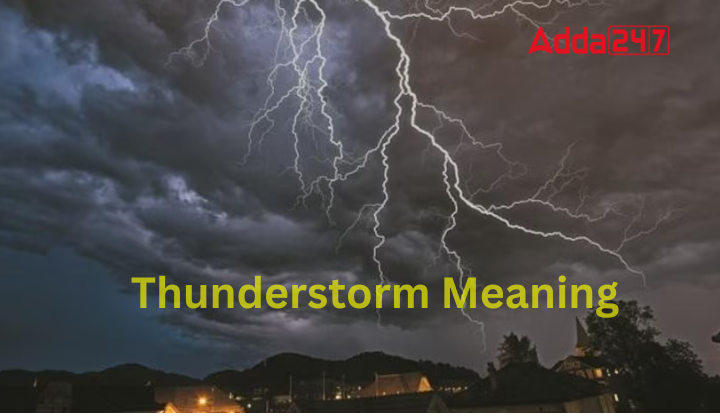Table of Contents
A thunderstorm, characterized by electric activity and often accompanied by lightning, generates audible effects in Earth’s atmosphere. These storms can emerge and intensify in various regions but are particularly common in mid-latitudes, where polar cold air mixes with warm, moist tropical air. India has experienced over 16 million thunderstorms to date.
This article provides insights into thunderstorms, including their definition, formation, causes, types, and lightning phenomena, essential for your geography preparation for the UPSC IAS exam. It addresses a substantial portion of the GS paper-1 syllabus.
What is Thunderstorm?
Thunderstorms are temporary, localized weather phenomena marked by lightning storms. These storms usually occur in warm, humid environments and can bring intense rainfall, hail, and strong winds. Most of these storms happen in the afternoon or evening and last for a few minutes to several hours.
Prediction of Thunderstorm
Predicting a scattered thunderstorm’s exact location and timing is challenging. Meteorologists rely on various statistical methods for forecasting thunderstorms. Utilizing output from Numerical Weather Prediction (NWP) forecast models is a preferred technique for amateur enthusiasts to assess the likelihood of thunderstorms.
Safety Measures During Thunderstorm
During thunderstorms, it’s important to take the following precautions:
- Seek shelter indoors during the storm.
- Avoid seeking shelter under trees or lying flat on the ground, as these increase the risk of danger.
- Indoors, steer clear of electrical fixtures, wires, metal objects, and water to minimize the risk of harm.
Formation of Thunderstorm
Thunderstorms originate from cumulonimbus clouds, which form when warm, humid air rises rapidly.
- Cumulonimbus clouds can ascend to heights exceeding 20 kilometres when warm, moist air is forced upwards.
- These clouds form due to the cooling and condensation of warm, moist air as it rises, reaching its dew point temperature.
- When the air cools sufficiently, water vapour condenses into water droplets or ice, leading to a decrease in pressure within the thunderstorm cell.
- Precipitation descends through the clouds along a lengthy path before reaching the Earth’s surface.
- As descending droplets collide with one another, they merge into larger droplets.
- The falling droplets create downdrafts that drag cold air behind them, spreading cold air over the Earth’s surface.
- Consequently, thunderstorms often generate powerful winds due to the downdrafts produced by falling precipitation.
Types of Thunderstorm
Thunderstorms can be categorized into different types based on their formation and characteristics. There are four main types of thunderstorms:
Single-cell Thunderstorms are the simplest and weakest type of thunderstorm. They are short-lived, typically lasting only 20-30 minutes, and form in areas with low wind shear (change in wind speed or direction with height). They are commonly referred to as “pop-up” thunderstorms because they can develop quickly on hot, humid afternoons. These storms typically produce brief, heavy rain and lightning.

Multicell Thunderstorms are the most common type of thunderstorm. They are formed by a line of updrafts and downdrafts that move together as a system. These storms can last for several hours and produce heavy rain, hail, strong winds, and even tornadoes. New cells form along the leading edge of the rain-cooled air, as older cells weaken and dissipate at the back of the line.

Squall lines are long lines of thunderstorms that can stretch for hundreds of miles. They are formed along cold fronts where warm, moist air collides with cooler, drier air. Squall lines can produce damaging winds, hail, and heavy rain. Squall lines move quickly and typically only last for a few hours.

Supercell Thunderstorms are the rarest and most severe type of thunderstorm. They are characterized by a rotating updraft, called a mesocyclone, that can reach speeds of over 100 mph. This rotation allows supercells to produce large hail, tornadoes, and very strong winds. Supercell thunderstorms can last for several hours and travel for hundreds of miles.

Stages of Thunderstorm
The formation of a thunderstorm unfolds in three stages, detailed below:
- Cumulus Stage:
-Intense heating of the ground occurs during daytime due to solar insolation.
-Vigorous lifting of an air parcel creates a low pressure, drawing in the surrounding air.
-Convection of warm, moist air leads to the formation of towering cumulonimbus clouds. - Mature Stage:
-Characterized by a strong updraft of rising warm air, resulting in the growth of larger, higher-reaching clouds.
-Subsequently, a downdraft brings rain and cool air to the Earth’s surface.
-The approach of a thunderstorm is often heralded by a strong wind gust, generated by significant downdrafts.
-The path of the thunderstorm is primarily determined by the interplay of updrafts and downdrafts, often unpredictable. - Dissipating Stage:
-Clouds ascend to a level where temperatures drop below freezing, leading to the formation of hail, followed by hail-producing storms.
-Abundant rainfall accompanies this process.
-Within minutes, the storm weakens, and clear skies emerge.



 Longest River in India, Check Top 10 Lon...
Longest River in India, Check Top 10 Lon...
 Namdapha National Park - Tiger Reserve, ...
Namdapha National Park - Tiger Reserve, ...
 India Neutrino Observatory (INO)-Types o...
India Neutrino Observatory (INO)-Types o...





